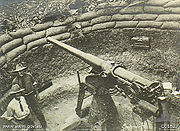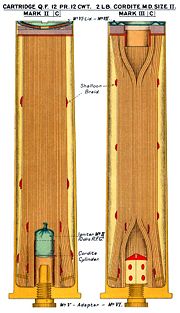
QF 12 pounder 12 cwt AA gun
Encyclopedia
The 12 pounder 12 cwt anti-aircraft gun was borrowed for AA use from the QF 12 pounder 12 cwt coast defence gun
with the addition of a modified cradle for higher elevation, a retaining catch for the cartridge, and an additional spring recuperator above the barrel and high-angle sights. Writers commonly refer to it simply as "12 pounder anti-aircraft gun". 12 cwt
referred to the weight of the barrel and breech (12 x 112 lb = 1,344 lb) to differentiate it from other "12 pounder" guns.
began Britain had no anti-aircraft artillery and had given little thought to it. Hence in 1914 when Germany occupied parts of Belgium and northern France, it faced the risk of air attack, and various medium calibre guns were adapted to high-angle mountings, including the 12 pdr 12 cwt. All QF 12 pounder ammunition at the time was "Separate loading QF" i.e. the propellant came in a brass cartridge case with primer ready installed, but the shell was loaded separately. For anti-aircraft firing, fixed QF rounds were quickly developed i.e. with the shell already attached to the cartridge case. This allowed slightly faster loading.
 For home air defence the gun was typically mounted on a high-angle mounting with an additional spring recuperator above the barrel, on a 2-wheel towed traveling platform, 7 ft (2.1 m) x 5 in 4 in (1.63 m) The 4 stabilising arms at the corners were swung out, rods at the ends screwed down to lift the platform off the wheels which were then removed and the platform lowered to the ground.
For home air defence the gun was typically mounted on a high-angle mounting with an additional spring recuperator above the barrel, on a 2-wheel towed traveling platform, 7 ft (2.1 m) x 5 in 4 in (1.63 m) The 4 stabilising arms at the corners were swung out, rods at the ends screwed down to lift the platform off the wheels which were then removed and the platform lowered to the ground.
It was also deployed on static mountings to defend prominent targets such as dockyards.
While the gun was much lighter than the QF 3 inch 20 cwt
dedicated AA gun, for anti-aircraft use it lacked its range and shell weight. Hence the 3 inch 20 cwt gun became the heavy AA gun of choice both on land and ships from 1914 to 1937. The 12 pdr 12 cwt also proved only marginally superior to the much lighter QF 13 pounder 9 cwt
as a light AA gun. Comparison :-
At the end of World War I
, 36 guns were still in service in the home air defense of Britain, 10 on the Western Front
and 2 in Mesopotamia where it was typically mounted on river barges.
The gun remained in Royal Navy anti-aircraft use, in the form of the new Mk V version, on smaller ships in World War II
because of its dual capability of both low and high angle firing.
QF 12 pounder 12 cwt naval gun
The QF 12 pounder 12 cwt gun was a common calibre naval gun introduced in 1894 and used until the middle of the 20th century. It was produced by Armstrong Whitworth, Elswick and used on Royal Navy warships, and exported to allied countries...
with the addition of a modified cradle for higher elevation, a retaining catch for the cartridge, and an additional spring recuperator above the barrel and high-angle sights. Writers commonly refer to it simply as "12 pounder anti-aircraft gun". 12 cwt
Hundredweight
The hundredweight or centum weight is a unit of mass defined in terms of the pound . The definition used in Britain differs from that used in North America. The two are distinguished by the terms long hundredweight and short hundredweight:* The long hundredweight is defined as 112 lb, which...
referred to the weight of the barrel and breech (12 x 112 lb = 1,344 lb) to differentiate it from other "12 pounder" guns.
History
When World War IWorld War I
World War I , which was predominantly called the World War or the Great War from its occurrence until 1939, and the First World War or World War I thereafter, was a major war centred in Europe that began on 28 July 1914 and lasted until 11 November 1918...
began Britain had no anti-aircraft artillery and had given little thought to it. Hence in 1914 when Germany occupied parts of Belgium and northern France, it faced the risk of air attack, and various medium calibre guns were adapted to high-angle mountings, including the 12 pdr 12 cwt. All QF 12 pounder ammunition at the time was "Separate loading QF" i.e. the propellant came in a brass cartridge case with primer ready installed, but the shell was loaded separately. For anti-aircraft firing, fixed QF rounds were quickly developed i.e. with the shell already attached to the cartridge case. This allowed slightly faster loading.
Combat use

It was also deployed on static mountings to defend prominent targets such as dockyards.
While the gun was much lighter than the QF 3 inch 20 cwt
QF 3 inch 20 cwt
The QF 3 inch 20 cwt anti-aircraft gun became the standard anti-aircraft gun used in the home defence of the United Kingdom against German airships and bombers and on the Western Front in World War I. It was also common on British warships in World War I and submarines in World War II...
dedicated AA gun, for anti-aircraft use it lacked its range and shell weight. Hence the 3 inch 20 cwt gun became the heavy AA gun of choice both on land and ships from 1914 to 1937. The 12 pdr 12 cwt also proved only marginally superior to the much lighter QF 13 pounder 9 cwt
QF 13 pounder 9 cwt
The 13 pounder 9 cwt anti-aircraft gun became the standard mobile British anti-aircraft gun of the World War I era, especially in theatres outside Britain...
as a light AA gun. Comparison :-
| Gun | m/v ft/s | Shell (lb) | Time to 5000 ft (1,524 m) at 25° (seconds) | Time to 10000 ft (3,048 m) at 40° (seconds) | Time to 15000 ft (4,572 m) at 55° (seconds) | Max. height (ft) |
| 13 pdr 9 cwt QF 13 pounder 9 cwt The 13 pounder 9 cwt anti-aircraft gun became the standard mobile British anti-aircraft gun of the World War I era, especially in theatres outside Britain... |
1990 | 12.5 | 10.1 | 15.5 | 22.1 | 19,000 |
| 12 pdr 12 cwt | 2200 | 12.5 | 9.1 | 14.1 | 19.1 | 20,000 |
| 3 inch 20 cwt QF 3 inch 20 cwt The QF 3 inch 20 cwt anti-aircraft gun became the standard anti-aircraft gun used in the home defence of the United Kingdom against German airships and bombers and on the Western Front in World War I. It was also common on British warships in World War I and submarines in World War II... 1914 |
2500 | 12.5 | 8.3 | 12.6 | 16.3 | 23,500 |
| 3 inch 20 cwt QF 3 inch 20 cwt The QF 3 inch 20 cwt anti-aircraft gun became the standard anti-aircraft gun used in the home defence of the United Kingdom against German airships and bombers and on the Western Front in World War I. It was also common on British warships in World War I and submarines in World War II... 1916 |
2000 | 16 | 9.2 | 13.7 | 18.8 | 22,000 |
At the end of World War I
World War I
World War I , which was predominantly called the World War or the Great War from its occurrence until 1939, and the First World War or World War I thereafter, was a major war centred in Europe that began on 28 July 1914 and lasted until 11 November 1918...
, 36 guns were still in service in the home air defense of Britain, 10 on the Western Front
Western Front (World War I)
Following the outbreak of World War I in 1914, the German Army opened the Western Front by first invading Luxembourg and Belgium, then gaining military control of important industrial regions in France. The tide of the advance was dramatically turned with the Battle of the Marne...
and 2 in Mesopotamia where it was typically mounted on river barges.
The gun remained in Royal Navy anti-aircraft use, in the form of the new Mk V version, on smaller ships in World War II
World War II
World War II, or the Second World War , was a global conflict lasting from 1939 to 1945, involving most of the world's nations—including all of the great powers—eventually forming two opposing military alliances: the Allies and the Axis...
because of its dual capability of both low and high angle firing.
Ammunition
 |
 |
Surviving examples
- Mk V anti-aircraft gun at Royal Artillery Museum, London
- Coast defence gun at Army Memorial Museum, Waiouru, New Zealand

